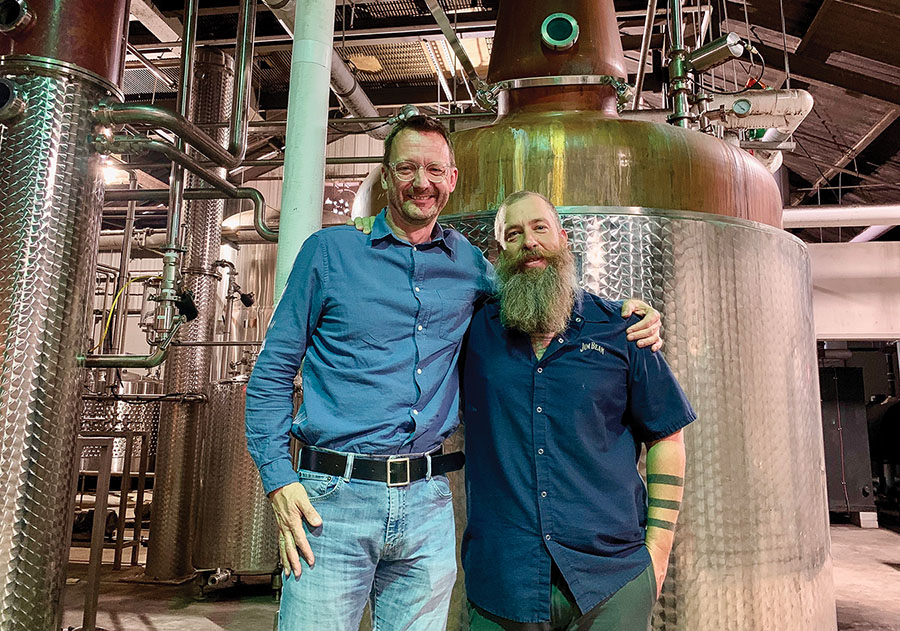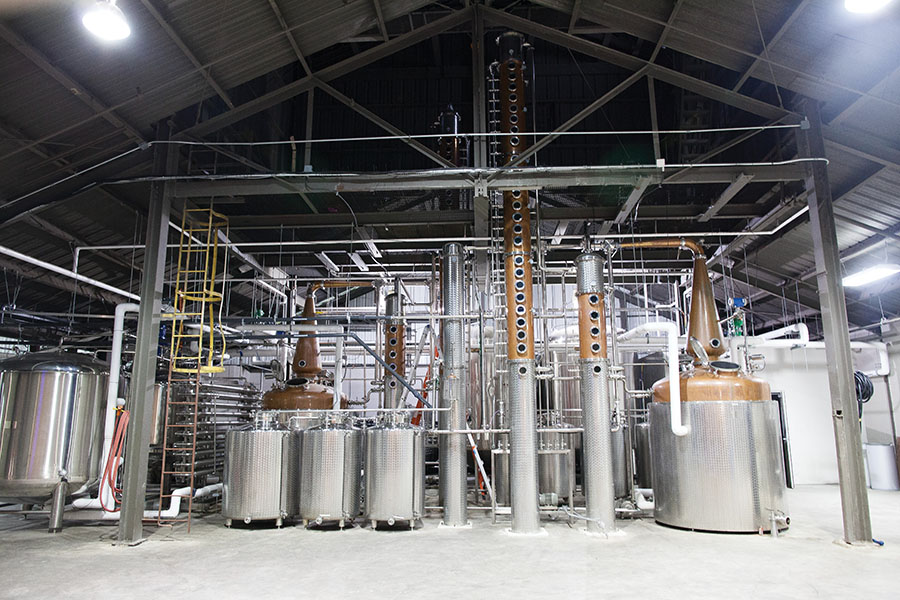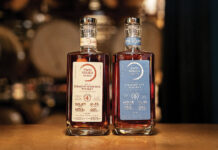A calm, tropical touch from the north Caribbean is gusting through balconies in the French Quarter, taming the sultry breath of New Orleans as visitors pass long storm shutters and old torches in the night. A few strangers head up a half-illuminated corridor to the front of a restaurant called Justine. In a district founded by the French, Justine is the main Parisian-style brasserie offering a traditional menu that stands apart from the city’s more famous Creole fare. It’s also been building a big reputation with its bartenders. One of them is mixing multiple cocktails at the moment, including one of Justine’s specialty drinks, the Ananas Martini, a blend of framboise, pineapple, lime, raspberry syrup, Citadelle Gin – and Bolden Vodka from Porch Jam Distillery.
They always make it with Bolden Vodka here at Justine.

Bolden is the first product that Porchjam’s founding distiller Gordon Stewart ever released. His team still makes it with a true-to-grain commitment, importing six-row malted barley and malted red winter wheat and then milling, mashing, fermenting, and distilling it themselves in the Third Ward of New Orleans. Stewart, originally from Scotland, intended Bolden to be a European-style vodka with some weight and mouthfeel. Bartenders working here in America’s most-European of cities have found it can really class-up a cocktail.
Anyone tasting the Ananas Martini inside Justine tonight will see it’s a sweet dream of a drink, the freshness of the vodka bringing delicate dimensions to its gentle citrus textures, its vanilla-lit body and the faint, foamy tartness at its center.
Most craft distilleries between New Orleans and Baton Rouge have tasting rooms. Conventional wisdom says that’s an obvious way to capitalize on the constant stream of national and international tourists pouring into South Louisiana. Porchjam may be one of the largest craft distilleries in the state, but it does not have a tasting room. Stewart, who previously taught marketing and business strategy at New Orleans’ Xavier University, says that he consciously decided to go in a different direction. Now that he’s finalizing deals for distribution to at least seven states, the unorthodox vision behind Porchjam seems to be proving out. Stewart believes there are three key components to making a distillery thrive in a travel destination without a tasting room. One of these strategies is on display for anyone strolling into Justine and opening its cocktail menu: It seems like everywhere you go in this town, you can order a drink with Porchjam spirits.
Porchjam’s approach — no neutral grain spirits, no distilling shortcuts, and absolutely no additives in Bolden Vodka — means that it retails for roughly $5 more per bottle than some of the store brands the public is most familiar with. So, how does an owner market the quality factor for a product like Bolden without tasting room personnel explaining it?
Stewart’s been accomplishing that, in part, by getting bartenders at some of New Orleans’ best-rated dining establishments on Tripadvisor to use his spirits for their cocktail action. This is especially true of Justine, a modern standout from the French Quarter’s century-old Creole landmarks Arnaud’s, Antoine’s, and Galatoire’s, as well as Pêche Seafood Grill, one of the hottest kitchens in the city’s trendy Central Business District. Foodie travelers intent on experiencing some of NOLA’s most cutting-edge cuisine tend to sidle up to the bars at Justine and Pêche, which means they can hear from the bartenders about Bolden Vodka and why it’s being used in their cocktails. It’s marketing top-quality spirits by associating with top-quality bar programs.
“One thing that trips up so many startup distilleries is understanding finance and understanding real marketing and how that functions,” Stewart observes. “Marketing is a process, and if you fail at any part of that process, you will not succeed.”
Stewart speaks with the experience of someone who’s polished the other side of the coin. Before moving to New Orleans 15 years ago, he owned a large brewpub in Glasgow, Scotland. He says he got plenty of people crowding in — the place was often packed. But with Porchjam Distillery, Stewart’s main intention was to build a commercial distillery on a scale that could eventually produce a volume of products for the national and international market. New Orleans has never had a distillery that size before. Stewart thought the roof and the marketing potential for long-term sales was off the chart. But he reasoned that a tasting room for his own team might be a distraction.
“I’ve run that race previously,” he notes. “In hindsight, I do not regret the decision. This is the rampant idealist part of me, right? I decided that if I’m going to make this, I’m going to pressure-test this business such that we do not have to split the focus. I approached this as somebody who absolutely lives, sleeps, breathes, digests, and dreams about alcohol. I love the manufacture of it. It’s what I get out of bed to do every morning. But I’m also a strategist. And I believe this business needed a purity of focus.”
And that purity of intention is reflected in the purity of Bolden Vodka itself, which a number of well-heeled diners are enjoying tonight over steak tartare, chicken confit, and escargot at Justine.
Believing in Rum Love
A few blocks from Justine, late-night drinking is gathering strength at a bar called The Will & the Way. The tavern has all the nocturnal nuances of the Big Easy, with that weathered funerary look to its windows and ghostly candles flickering against its solemn, black-painted walls. The ambiance here calls back to 19th- century drinking dens that once stood under Spanish moss and Southern moonlight. There’s also a sense of those Creole watering holes that existed in 1835 when a New Orleanian named Norbert Rillieux developed a novel method of processing raw sugarcane. Rillieux’s breakthrough had real implications for food and drinks. In the years that followed, it became clear that Louisiana could grow sugarcane just as well as the islands scattered south of it in the Caribbean.

By 1865, bottles like Rhum Louisiane were stocking saloons from Baton Rouge to Grand Island. But this art was lost in the Pelican State for decades after Prohibition — at least, until New Orleans’ Celebration Distillery (now the country’s oldest continually operated rum distillery) began slowly reviving the tradition in 1999. Today, “the City that Care Forgot” has an array of rum distilleries that no one wants to forget. And for the cocktail masters here at The Will and the Way, one of its shining lights is Porchjam.
That has a lot to do with Stewart’s partnership with his current head distiller, Jason Zeno.
The founding Scotsman may have been the first man working Porchjam’s stills back in 2011 when he converted a run-down coffee plant near the city’s old Pelican Stadium into a gleaming double-pot and column system with 4 and 24 plates. But after shifting his energies to expanding distribution, he brought in Zeno to be his main spirit master. A native of Pittsburgh, Pennsylvania, Zeno is a commercial distilling vet from Beam Suntory. However, since arriving in New Orleans, Zeno has been driving a passion project that has nothing to do with whiskey traditions: making white and aged rum from raw Louisiana cane juice. He and Stewart have named this rum brand Cheramie. They choose not to call it an agricole, since it’s not made in the French Caribbean, nor are they claiming it’s a clairin, because it’s not from Haiti; though both are close cousins to what the distillery is producing. In the minds of the Porchjam boys, Cheramie is Cheramie.
In the minds of the bartenders at The Will and the Way, it’s a brilliant take on rum that stands out. They particularly recommend adding Cheramie to a classic daiquiri or a Mai Tai. Tonight, as their sanctuary of shadows starts to get crowded, they’re making a Mai Tai with it: The finished drink has a chartreuse color under the candle shimmer, the Cheramie bolstering its sweet and sour contours and punching up the brilliance in its lime effect.
“To use the raw juice and our geographical advantage, I really wanted to lean into that, because these are the types of rums that Gordon and I love — and they truly taste like the cane they came from,” Zeno says. “There’s a continuity if you go out to the cane fields, and if you go to the sugar mill that we use in Franklin, Louisiana, and if you smell our cane wine as it’s fermenting — all the way through what’s distilled — you’ll sense that continuity in the whole process. We actually put a vintage even on our blanc rum, because it’s pretty consistent, even though I can’t control cane crops from year to year.”
One of the ways that Zeno and Stewart make Chermanie work is with their 6,000-gallon ISO tank truck, which they bring often to the Franklin cane mill, which actually installed a juice line just for Porchjam’s set of wheels. That was originally a one-inch line, but with Cheramie taking off in the last year, the mill changed it to a four-inch line.
“We send the truck down there, the juice gets filled up, we give it to our fermentors, and then it’s in a temperature-controlled environment,” Zeno explains. “The good bartender who knows it will say it has a little salinity to it and it has some grass character: It tastes like an agricole would, but it’s approachable.”
Creating something like Cheramie falls into Stewart’s second big piece of advice for making a distillery work without a tasting room: Have a product you absolutely believe in.
Stewart stresses that spirit fans are more educated than ever. In his view, the days when a producer could stick up a billboard and watch people flock to whatever label they saw on it are absolutely over. Stewart says it’s now about bringing something special, unique, and excellent to the table.
“If we think we can pull the wool over consumers’ eyes and just dial it in with a product, I think that’s a real error,” he notes. “We have to be making the very best products we can; and if that means having more restrictive margins — if that means assuming a little bit more risk — then so be it.”
This City
Grungy saxophone tones roll through the dining room like a swamp train, streaming from speakers in the worn Creole cottage and breaching its Spanish courtyard where vines tussle under those haunting clouds after sundown. This French Quarter hideaway is called The Jewel of the South. Just across the way from the city’s oldest cemetery, it’s a dining destination that’s established its bona fides partly by having some of the top bartenders in New Orleans. That makes it a stop for drink geeks chasing the most historic and carefully curated cocktails in the birthplace of jazz. The Jewel’s mixologists are known for making the Brandy Crusta, one of the first concoctions ever stirred on the banks of the Mississippi, as well as the Cajon Bon Vivant, an unapologetic blend of pork-fat washed rums, smoked maple syrup, and Jamaican bitters.
But another popular offering from its bar is the Columbina. The waiter who’s bringing that drink out now describes it as a sharper version of the Gimlet. The Jewel makes it with pineapple green tea cordial, génépy, lime and Gravier Gin from Porchjam Distillery. The Gravier gin is a must — it’s written into the menu.
Stewart and Zeno wanted Gravier to be a Plymouth-style gin with a classic feel, though still having a touch of modern botanical intrigue. When stirred into the Columbina, its profile puts an electric lemon-drop elevation into the cooler melon-shine that the cocktail is known for.
The fact that The Jewel of the South, with its specific notoriety, would look to Gravier Gin for one of its staples is a testament to Stewart’s third piece of advice on running a distillery without a tasting room: “You have to own your own backyard,” he stresses.
The adopted New Orleanian points out that distillers might think they’re developing a home-run product, but if their business is anchored in a spot with a culinary reputation and some serious kitchen and bar talent — along with droves of discerning connoisseurs — then that can equal a sobering heat-check for what’s actually inside the bottles.
Not only can local restaurateurs and bar experts act as a quality compass, they can also offer a path to helpful networking if they are believers.
“There are distilleries that fail, every month — every week — that are in the middle of the biggest cities in the world,” Stewart reflects. “You have to learn to build your network, nuance your network, and sustain your network, because within that, that’s where opportunity lies. I’m an optimist. I think people are always trying to help us.”
And Stewart believes that’s especially true of New Orleans. One thing that he and Zeno have in common is hard-scrabble, inner city experiences in their backgrounds. In Zeno’s case, he grew up in a hollowed-out Pittsburgh that was falling into the center of the Rust Belt apocalypse. Zeno’s early years were spent watching the city’s painful deindustrialization, which included its manufacturing industry being driven off a cliff while half its generational steel jobs were shipped overseas.
Stewart, on the other hand, was raised in Glasgow in a time of its most dire poverty. The soul-crushing bleakness of that moment was recently captured by Douglas Stewart — an author from Gordon Stewart’s own neighborhood — in the 2020 Booker Prize-winning novel Shuggie Bain. Early mortality rates are still so troubling for older residents in the city that British health experts call the phenomenon “the Glasgow Effect.”
But those tough backgrounds have made Stewart and Zeno gravitate toward the New Orleans craftspeople and business owners that they now work with. The transplant distillers say they’ve discovered a city where historic struggle has always been balanced with creative flourishing and a relentless will to survive. Stewart and Zeno have both been through numerous hurricanes at this point, along with political and pandemic-related upheavals. The way their neighbors have responded, and the support people have shown each other, has convinced the duo they’re in the best possible place to chase their vision.
“I just had a kid nine months ago, and I’m so happy she’s going to grow up here,” Zeno muses. “It’s the people. It’s the community — and how passionate they are. I’ve told my wife that I don’t want to live anywhere else in this country. Don’t get me wrong, it’s not easy to live here — infrastructure problems, leadership problems, storms, floods, crime — all these things, but they mean that you earn being a New Orleanian; and it makes it even that much more satisfying.”
He adds, “You can be your truest self. And everyone is their truest self, for better or worse.”
Stewart agrees.“New Orleans quite literally saved me,” he acknowledges. “I came here during a big life change 15 years ago, and now I couldn’t imagine living anywhere else. And I swear to God, I will never leave this city.”








